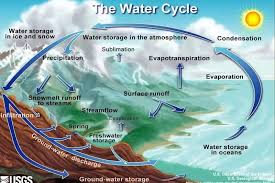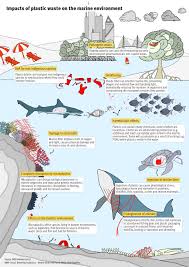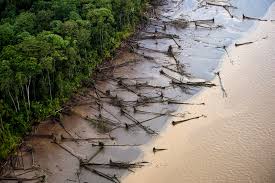By Study Rhino
Water is one of the most important resources on Earth. It supports all forms of life, helps regulate the planet’s temperature, and shapes the environment around us. But have you ever wondered how water keeps moving across the Earth, from the oceans to the sky, into rivers and underground? This continuous movement of water is called the water cycle, and understanding it is key to appreciating how our planet works.
In this article, we’ll explore what the water cycle is, its main stages, why it is important, and how humans are impacting it.
What Is the Water Cycle?
The water cycle, also known as the hydrologic cycle, describes how water moves through the Earth’s atmosphere, surface, and underground. It is a never-ending, natural process driven primarily by the energy of the sun. Water changes forms during this cycle — turning into vapor, liquid, and even ice — depending on the conditions.
Even though water is constantly moving and changing forms, the total amount of water on Earth stays the same. The water you drink today could have once fallen as rain during the time of the dinosaurs!
The Main Stages of the Water Cycle
The water cycle has several important stages. Let’s break them down:
- Evaporation
Evaporation is the process where water changes from a liquid to a gas (water vapor). The sun’s heat causes water in oceans, rivers, lakes, and even puddles to evaporate into the air.
- Example: After it rains, a puddle eventually dries up due to evaporation.
Not only open water surfaces contribute to evaporation. Water also evaporates from soil and plants through a process called transpiration.
Together, evaporation and transpiration are sometimes referred to as evapotranspiration.
- Condensation
As water vapor rises and cools in the atmosphere, it changes back into tiny liquid droplets, forming clouds. This process is called condensation.
- Example: Think about how a cold glass of water “sweats” on a hot day — that’s condensation happening at a small scale.
Condensation is crucial because it leads to cloud formation, which is essential for the next stage: precipitation.
- Precipitation
When clouds become heavy with water droplets, the water falls back to the Earth in the form of precipitation. Depending on the temperature, precipitation can fall as:
- Rain
- Snow
- Sleet
- Hail
Precipitation replenishes water in rivers, lakes, and the ground, making it a vital part of life on Earth.
- Collection
Once water reaches the ground, it doesn’t just sit there. It collects in various places:
- Surface Water: Water collects in oceans, lakes, rivers, and streams.
- Groundwater: Some water soaks into the ground, filling up underground aquifers.
- Runoff: Water that flows over land into rivers and oceans without soaking into the ground.
This collected water then becomes available for evaporation again, restarting the cycle.
Other Important Processes in the Water Cycle
Beyond the main stages, several other processes help move water through the environment:
Infiltration
Infiltration occurs when water seeps into the soil. The water may move deeper to join underground reservoirs, or aquifers, which people often tap into for drinking water.
Sublimation
Sometimes, ice and snow can change directly into water vapor without becoming liquid first. This rare process is called sublimation.
- Example: Snow disappearing from a mountaintop without melting first.
Deposition
The reverse of sublimation, deposition is when water vapor turns directly into ice, forming frost without becoming liquid.
Percolation
This refers to the movement of water through the soil and porous rocks to recharge groundwater supplies.
Why Is the Water Cycle Important?
The water cycle is crucial for many reasons:
- Supports Life
Without the constant recycling of water, living organisms would not have access to the fresh water needed to survive. Plants absorb groundwater through their roots, animals drink from surface water sources, and humans use water for drinking, agriculture, and industry.
- Regulates Climate
The water cycle helps to distribute heat around the globe. Evaporation cools surfaces, while condensation releases heat into the atmosphere. This exchange of heat plays a major role in weather patterns and climate regulation.
- Shapes the Landscape
Over time, precipitation, rivers, and glaciers reshape Earth’s surface. Erosion by water creates valleys, canyons, and other geological features.
- Purifies Water
As water moves through the cycle, it undergoes natural purification processes. For example, when water evaporates, impurities are left behind, creating cleaner water vapor.
Human Impact on the Water Cycle
Unfortunately, human activities are affecting the natural flow of the water cycle in several ways:
Pollution
Pollutants from agriculture, industry, and waste can contaminate water sources. When polluted water evaporates, some harmful substances can be carried into the atmosphere or deposited back to Earth with precipitation, known as acid rain.
Climate Change
By increasing greenhouse gas emissions, humans are warming the planet, which affects the water cycle. Warmer temperatures mean more evaporation and more intense storms. Melting glaciers and changing rainfall patterns can lead to droughts in some areas and floods in others.
Deforestation
Trees play an important role in transpiration. Cutting down forests reduces the amount of water vapor released into the air, which can disrupt local rainfall patterns and contribute to desertification.
Overuse of Water Resources
Excessive extraction of groundwater for farming and urban use can deplete aquifers faster than they can naturally recharge. This not only affects water availability but also can cause land to sink — a process called subsidence.
Fun Facts About the Water Cycle
- About 97% of the Earth’s water is salty and found in oceans.
- Only about 3% of Earth’s water is freshwater, and most of it is locked in ice caps and glaciers.
- A single drop of water can travel around the Earth and through the atmosphere multiple times over thousands of years.
- The Amazon rainforest produces about 20% of the world’s freshwater through transpiration.
- Some raindrops can fall from clouds over 5,000 meters high!
How to Protect the Water Cycle
Everyone can help protect this vital system by:
- Saving water: Turn off taps, fix leaks, and use water-efficient appliances.
- Reducing pollution: Properly dispose of chemicals and waste.
- Planting trees: Trees help maintain healthy local water cycles.
- Using sustainable practices: Support eco-friendly farming and land use.
By understanding the importance of the water cycle and taking small actions, we can help keep this incredible natural system healthy for future generations.
Conclusion
The water cycle is an amazing and complex system that keeps our planet alive and thriving. From the smallest droplet to massive oceans, water is always on the move, cycling through evaporation, condensation, precipitation, and collection. Understanding the water cycle helps us appreciate the delicate balance of nature and the importance of protecting our environment.
Next time you see a cloud, a puddle, or a flowing river, remember — you’re witnessing part of a beautiful, ancient process that connects all living things. Let’s do our part to cherish and safeguard it!
Would you also like me to create a simple infographic version of this article? 🌍💧 It would be super helpful for students!




